10.0 MISSILES && ARTILLERY
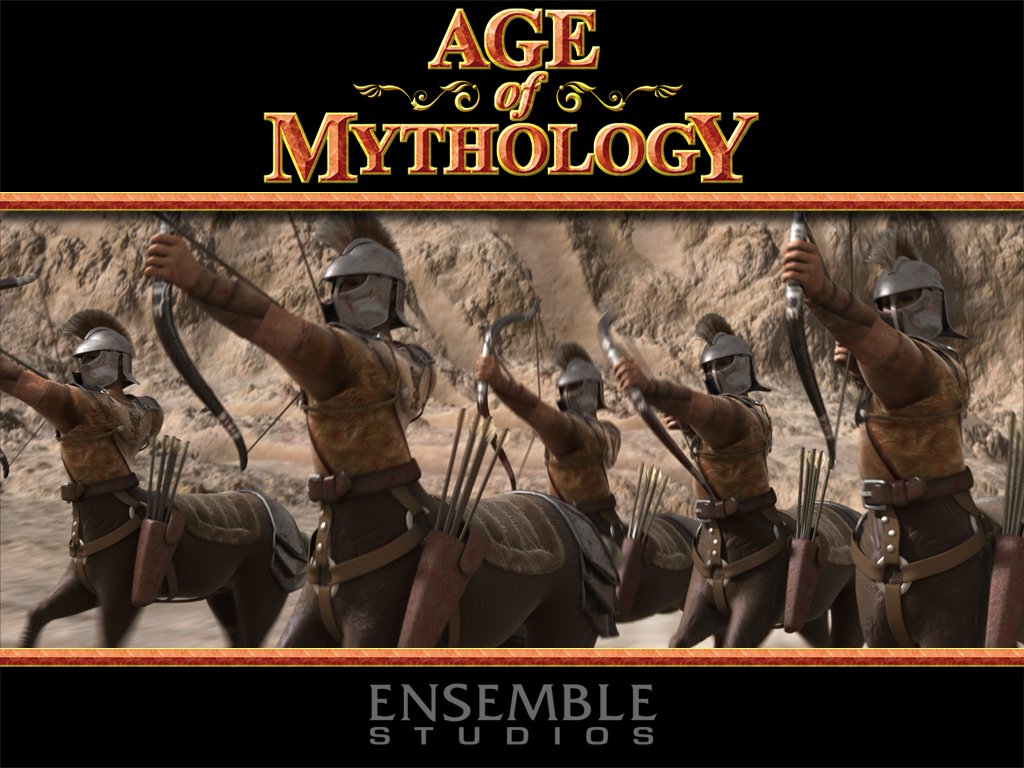
10.0 MISSILES && ARTILLERY

| A. MISSILE WEAPONS | 10.1 Who can use missiles | 10.2 When missiles are used | 10.3 Ammunition | 10.4 Movement and missile fire |
| 10.5 Split-fire | 10.6 Pass-through fire | 10.7 Indirect fire | 10.8 Missile fire modifiers | - |
| B. ARTILLERY | 10.9 Artillery weapons | 10.10 Artillery crews | 10.11 Special artillery ammunition | |
| - | - | Battlesystem | - | - |
10.0
MISSILES AND ARTILLERY
Missile weapons and battlefield artillery can be used
during the Initial Missile Phase, the Movement Phase (as
pass-through-fire), and the Missile and Magic Phase of
the Game Round.
PROCEDURE
All missile weapons usable by
characters in the AD&D and D&D
games can be used in the
BATTLESYSTEM game. The range of
missile weapons and the number of shots
per Game Round are the same as in the
AD&D and D&D games. Missile
weapons can be used during the Initial
Missile Phase, the Movement Phase (see
[10.6] PASS-THROUGH FIRE), and the
Missile and Magic Phase of the Game
Round, depending on the number of shots
per Game Round of the missile weapon
used.
USE the BATTLESYSTEM melee
combat procedure for missile weapons.
Unlike melee combat, figures killed by
missile fire are removed
immed. -- they do not get to return
fire before being removed.
All members of a unit must be armed
with missile weapons in order for them to
be used. A unit that is in base-to-base
contact with enemy figures cannot USE
missile weapons.
A figure using missile fire must be able
to trace a line of sight tot its intended
TARGET (45 degrees to either side of the
figure). If only a portion of the intended
TARGET can be seen, the figure can still
shoot, but at a penalty (see [10.8]
MISSILE FIRE MODIFIERS). If only part
of a unit can see an enemy unit, only
those figures who can see the enemy unit
can shoot. If only part of the enemy unit
can be seen, all enemy losses must be
taken from the figures visible to the firing unit.
If more losses are called for by the
combat result than there are figures that
can be seen, ignore remaining losses.
If a unit of archers (short bow, long
bow, or composite bow, but not
crossbow) is in closed || open order the
first two rows of archers can fire. If a unit
is using any other missile weapon, only
the first row can fire.
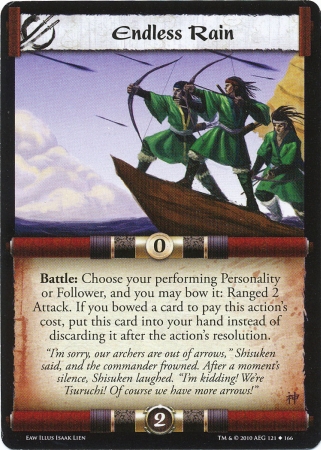
Missile weapons can be used during the Initial Missile
Phase,
the Movement Phase (as pass-though-fire), and
during the Missile and Magic Phase.
A unit can only fire during the Initial
Missile Phase if it is entitled to two or
more shots during a Game Round.
Regardless of the number of shots a unit is
allowed, it can only fire a max. of
one time during the Initial Missile Phase.
A unit that has at least one shot
remaining during the enemy Movement Phase
can eleect to fire a max. of one
shot as Pass-Through Fire ([10.6]). A unit
does not have to be entitled to more than
one shot per game round in order to use
pass-through fire.
A unit can fire any or all of its
remaining shots during the Missile and
Magic Phase. If it has already used all its
shots during the Initial Missile Phase and
the enemy Movement Phase, it cannot fire
during the Missile and Magic Phase.
Units can also elect to MOVE and shoot
(see [10.4] MOVEMENT AND MISSILE
FIRE), or take split-fire (see [10.5]
SPLIT-FIRE).
If an enemy figure or figures moves into
base-to-base contact w/ a figure || unit
that has already used missile weapons
during the current Game Round, the
missile-firing unit cannot fight during that
Melee Phase.
Q: Can missiles be
fired into melee?
Can pass-through fire be
used
against units performing
wrap
arounds?
A: Missiles cannot
be fired into melee (at
least those involving your
own allies).
Wrap-around occurs during
the movement
phase, and figures performing
such movement
are subject to pass-through
fire.
(132.34)
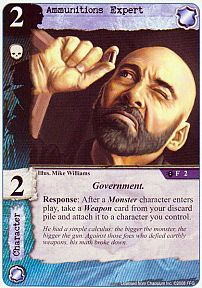
Units using normal (non-magical)
arrows, quarrels, stones or bullets
as
missiles have an unlimited supply of
ammunition. (A specific scenario may
specify a limit on ammunition). Units
using any other types of missiles have a
limited number of weapons. Each player
must the number of axes, javelins,
spears, magic arrows, etc., each member
of a unit carries, and mark off weapons as
they are expended. (A specific scenario
may specify a limit; otherwise, assume
each member of a unit is armed with two
volleys.)
[10.4] MOVEMENT AND MISSILE FIRE
If a unit using missile weapons fires
during a Game Round, its movement is
limited during that Game Round. A unit
that fires missile weapons cannot charge
during that Game Round.
A missile-firing unit's movement during
the same Game Round is limited
according to the following table:
Table 12: Movement and Missile Fire.
| Missile Weapon | Movement Restriction |
| Thrown Weapons | Fire once and 1/3 movement penalty |
| Crossbows/Slings | Either move or shoot |
| Archers | Fire twice and not move,
fire once and 1/2 movement penalty |
| Mounted Archers | Fire twice and not move,
fire once and move full movement rate |
| Mounted Crossbows | Fire once and 1/2 movement penalty |
Archers mounted on other creatures, or
centaur archers, can move 1/2 of their
movement rate, fire at eligible enemy
units, then continue moving the
remainder of their movement rate.
Creatures with breath weapons or
innate missile weapons (e.g., needlemen)
can also split-fire.
Units that are eligible during the
Missile and Magic Phase can fire at enemy
units during the enemy Movement Phase
by declaring that they will take
Pass-Through-Fire. Pass-through fire can
be taken at any point during the enemy's
movement. Pass-through fire can be used
against enemy units that subsequently
engage the firing unit in melee combat, or
against any enemy units in range and line
of sight.
Artillery weapons can also USE
pass-through fire.
Q: Can missiles be
fired into melee?
Can pass-through fire be
used
against units performing
wrap
arounds?
A: Missiles cannot
be fired into melee (at
least those involving your
own allies).
Wrap-around occurs during
the movement
phase, and figures performing
such movement
are subject to pass-through
fire.
(132.34)
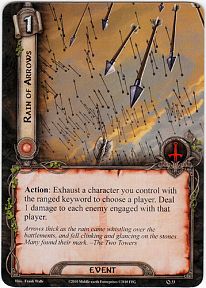
"Arrows
thick as the rain came whistling over the battlements, and fell clinking
and glancing on the stones.
Many
found their mark". - The Two Towers
Archers can sometimes shoot over
friendly troops to hit the enemy. This is
called Indirect Fire. To USE indirect fire,
the archers must be in command and at
least 3" away from the friendly troops
over which they are firing.
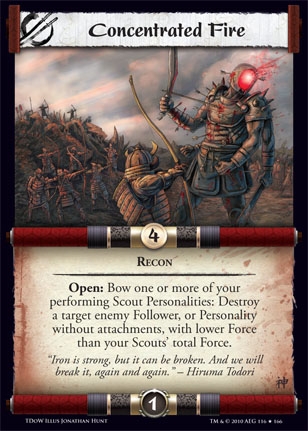
The following bonuses and penalties are
applied to the AR of missile troops prior
to rolling the die.
Table 13: Missile Fire Modifiers
| TARGET is in open or skirmish formation | +1 |
| TARGET is in woods or behind hedge | +2 |
| TARGET is in building or behind wall or in Shield Wall formation [11.6] <link> | +4 |
| Missile-using troops are mounted | +2 |
| Missile-using troops are using Indirect Fire | +3 |
| TARGET is at Medium Range* | +2 |
| TARGET is at Long Range* | +5 |
* Use the standard AD&D game penalties
for the D&D game as well.
Ignore D&D game missile adjustments for range.
<slight variance, an or instead of a comma at line 3>
Q: When can enemy
archers shoot at
a hero? Can opposing archers
"sharpshoot" at a hero ?
that is,
shoot at only him when he
is with a
unit, or alone and engaged
in melee
with a unit?
A: If the hero is
actually attached to a unit
(in command or fighting
with it), archers
cannot pick him out. If
the figure is not
attached, he can be a target.
A hero in
melee with a unit can't
be fired on because
the unit he is fighting
is a much bigger
target than he is -- besides,
the hero's foes
might be your own allies.
(127.14)
B. ARTILLERY
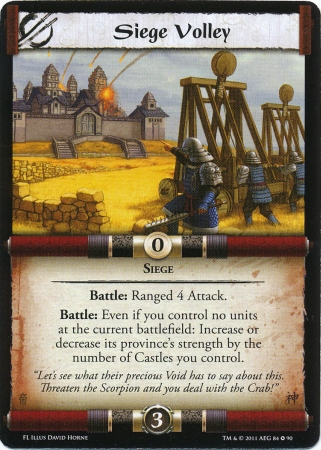
There are two types of field artillery
used in the BATTLESYSTEM gaem:
catapults and ballistae.
Artillery weapons can MOVE only along
roads or clear terrain ([11.8]).
Q: How do you determine
whether or
not artillery fire hits
a tree, assuming
that the fire is deliberately
aimed at the tree?
A: Treat the target
tree just like any other
artillery target (see page
19 of the rule
book).
(132.34)
A catapult cannot shoot at a TARGET closer
than its Min. range. It can USE
indirect fire at normal penalties. A
catapult's TARGET is always considered to
be AC5, regardless of the actual AC of
the TARGET. It can fire every other Game
Round.
LIGHT CATAPULT:
Range: Min = 15", S = 20", M = 25", L = 30"
Damage: 2d10
MV: 8"
HEAVY CATAPULT
Range: Min = 18", S = 24", M = 30", L = 36"
Damage: 2d12
MV: 4"
A ballista can fire every Game Round. It
must be able to trace a straight line of
sight to its TARGET, and cannot USE indirect
fire. A ballista's TARGET is always
considered to be AC 10, regardless of the
actual AC of the TARGET.
BALLISTA:
Range: S = 11", M = 22", L = 32"
Damage: 2d6
MV: 6"
[10.10] ARTILLERY CREWS
Each artillery piece must have a crew.
An artillery crew must be human,
demihuman, or humanoid, and is
represented by one figure with 10 or more
HD (10:1, 5:1, 2:1, or 1:1 ratios, as
desired).
The AR of an artillery piece is the same
as teh the THACO of its crew figure, not
adjusted for ratio. If the original crew
figure is removed, any replacement crew
figure has a +2 AR penalty for the
duration of the battle.
If an artillery crew is wounded, the
artillery piece cannot MOVE. A wounded
artillery crew can fire only at 1/2 normal
rate.
An artillery crew figure is considered to
be a skirmish unit for the purposes of
command, movement, and melee.
[10.11] SPECIAL ARTILLERY AMMUNITION
In addition to boulders and arrows,
field artillery can be used to fire a variety
of items, ranging from glass balls filled
with green slime to magical items
of
destruction. It is the using player's
responsibility to work out the details of all
such special ammunition with the referee
or other players before the game begins.
![]()
Reduce - Reuse - Recycle